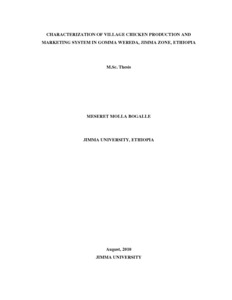Resource information
This study was conducted to characterize the production and marketing system of village chickens in Gomma Wereda of Jimma Zone. Six Kebeles were selected using multistage random sampling from each of which 30 Households (HHs) were randomly selected. A survey was conducted on the selected HHs pertaining indigenous chicken management, marketing and productivity. Fresh eggs (purchased from the household) and market eggs (purchased from the local market) were studied for quality and hatchability. Finally close follow up of the farmers who adopted improved poultry using hay-box brooder under IPMS project in the Wereda was made for comparative study over a period of 5 months. The results obtained showed that mean flock size/HH in Gomma Wereda is 6.2 indigenous chickens. About 94.4% of the respondents indicated that there is no separate poultry house, and the feeding system is based on full day scavenging with supplementation. Poultry diseases are widely spread and 85.6% of the respondents reported serious and occasional disease outbreak commonly resulting in complete devastation. Live bird and eggs are sold in an open market. Egg storage conditions and market live bird and egg transportation practices contribute to disease spread and egg quality deterioration as measured by changes in egg weight, albumen height and, HU of eggs collected from market places of Gomma Wereda. The Production Performance of the indigenous chickens of Gomma Wereda, as measured by rates of chick survival, sexual maturity and laying looks fairly good compared to that of central highlands and southern Ethiopia. In contrast, the results of the survey and egg incubation trials conducted clearly indicated that percent hatchability as measured by the number of fertile eggs that hatched into normal chick was found to be very low (27.4 %). According to the majority of the respondents household poultry is source of income that benefits women since about 96.7% of the chicken population of the Wereda are reported to be owned by women who are said to be responsible for making almost all the major decisions concerning poultry. The results of this study also showed that farmers who adopted exotic chickens under IPMS farmers-project in the Wereda, were successful in raising layer type day old chicks with the use of hay-box brooder. Mean egg production of the exotic layers kept in separate poultry house and fed with commercial ration was reported to be about 0.7egg/hen/day.In summary the results of this study tends to indicate that improvement in hatchability seems to be the future direction of research in the Gomma Wereda.



